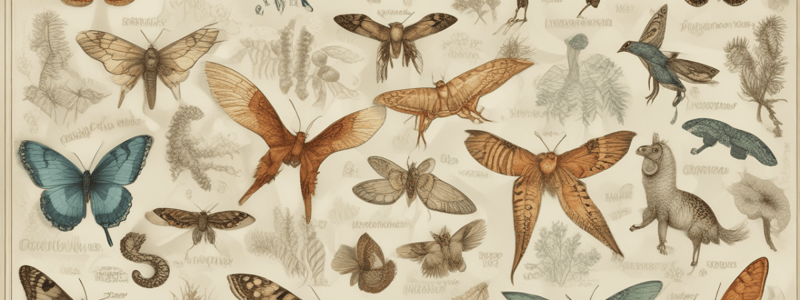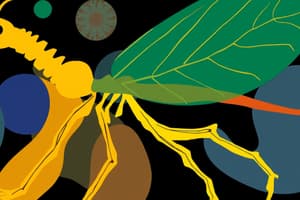Podcast
Questions and Answers
What is the science of characterizing organisms in order to arrange them into hierarchical groups?
What is the science of characterizing organisms in order to arrange them into hierarchical groups?
- Identification
- Nomenclature
- Taxonomy (correct)
- Horizontal Gene Transfer
What is the process of characterizing an isolate in order to determine the group to which it belongs?
What is the process of characterizing an isolate in order to determine the group to which it belongs?
- Identification (correct)
- Classification
- Horizontal Gene Transfer
- Nomenclature
What is the term for the transfer of DNA from one organism to another through conjugation, DNA-mediated transformation, or transduction?
What is the term for the transfer of DNA from one organism to another through conjugation, DNA-mediated transformation, or transduction?
- Species
- Taxonomy
- Horizontal Gene Transfer (correct)
- Genus
What is the basic unit of taxonomy?
What is the basic unit of taxonomy?
What is the term for a group of closely related strains?
What is the term for a group of closely related strains?
What is the term for a collection of related species?
What is the term for a collection of related species?
What is the term for a collection of similar kingdoms?
What is the term for a collection of similar kingdoms?
What tracks bacterial strains causing foodborne diseases?
What tracks bacterial strains causing foodborne diseases?
What is the primary purpose of Bergey's Manual of Systematic Bacteriology?
What is the primary purpose of Bergey's Manual of Systematic Bacteriology?
Why is it important to identify the genus and species of an isolate in clinical laboratories?
Why is it important to identify the genus and species of an isolate in clinical laboratories?
What is the basis for classification in the newest edition of Bergey's Manual?
What is the basis for classification in the newest edition of Bergey's Manual?
What might happen if the properties of a newly isolated prokaryotic organism do not match any description in Bergey's Manual?
What might happen if the properties of a newly isolated prokaryotic organism do not match any description in Bergey's Manual?
Why might it be easier to determine the cause of pneumonia than the cause of a wound infection?
Why might it be easier to determine the cause of pneumonia than the cause of a wound infection?
What is the main difference between the newest and previous editions of Bergey's Manual?
What is the main difference between the newest and previous editions of Bergey's Manual?
Why might some biologists be reluctant to accept the three-domain system?
Why might some biologists be reluctant to accept the three-domain system?
What is the primary method of identification in clinical laboratories?
What is the primary method of identification in clinical laboratories?
What type of microorganisms are members of the genus Mycobacterium?
What type of microorganisms are members of the genus Mycobacterium?
What is the purpose of using an acid-fast stain in a patient with symptoms of tuberculosis?
What is the purpose of using an acid-fast stain in a patient with symptoms of tuberculosis?
What is a characteristic of colonies of the bacterium Serratia marcescens when incubated at 228C?
What is a characteristic of colonies of the bacterium Serratia marcescens when incubated at 228C?
What is a characteristic of cultures of Pseudomonas aeruginosa?
What is a characteristic of cultures of Pseudomonas aeruginosa?
What is the purpose of using metabolic capabilities in identifying microorganisms?
What is the purpose of using metabolic capabilities in identifying microorganisms?
What type of medium is used to detect the presence of E. coli?
What type of medium is used to detect the presence of E. coli?
What is the purpose of using colony morphology in identifying microorganisms?
What is the purpose of using colony morphology in identifying microorganisms?
What is the analogy used to describe the process of identifying microorganisms based on their metabolic capabilities?
What is the analogy used to describe the process of identifying microorganisms based on their metabolic capabilities?
What is the purpose of placing paper discs containing different antibiotics on the agar?
What is the purpose of placing paper discs containing different antibiotics on the agar?
Why is it difficult to determine the evolutionary relationships of microorganisms?
Why is it difficult to determine the evolutionary relationships of microorganisms?
What is the limitation of using phenotypic traits to classify prokaryotes?
What is the limitation of using phenotypic traits to classify prokaryotes?
What is the advantage of using molecular techniques to identify microorganisms?
What is the advantage of using molecular techniques to identify microorganisms?
What is the purpose of the antibiogram?
What is the purpose of the antibiogram?
What is the limitation of using fossilized stromatolites to study microorganisms?
What is the limitation of using fossilized stromatolites to study microorganisms?
What is the characteristic of strains of a given species?
What is the characteristic of strains of a given species?
What is the significance of DNA sequencing techniques in prokaryotic classification?
What is the significance of DNA sequencing techniques in prokaryotic classification?
What is the purpose of inoculating a stool sample onto a special agar medium?
What is the purpose of inoculating a stool sample onto a special agar medium?
What is the significance of the sorbitol-MacConkey agar medium?
What is the significance of the sorbitol-MacConkey agar medium?
What is the process of comparing the restriction fragment length polymorphism (RFLP) patterns of E.coli O157:H7 isolates used for?
What is the process of comparing the restriction fragment length polymorphism (RFLP) patterns of E.coli O157:H7 isolates used for?
What is the outcome if two isolates have identical RFLP patterns?
What is the outcome if two isolates have identical RFLP patterns?
What is the purpose of the CDC's investigation in the E.coli O157:H7 outbreak?
What is the purpose of the CDC's investigation in the E.coli O157:H7 outbreak?
What is the outcome of the CDC's investigation in the E.coli O157:H7 outbreak?
What is the outcome of the CDC's investigation in the E.coli O157:H7 outbreak?
What is the significance of the restriction enzymes in the process of RFLP?
What is the significance of the restriction enzymes in the process of RFLP?
What is the purpose of the gel electrophoresis in the process of RFLP?
What is the purpose of the gel electrophoresis in the process of RFLP?
Flashcards are hidden until you start studying
Study Notes
Classification of Organisms
- There are three domains: Bacteria, Archaea, and Eukarya
- Kingdoms are grouped into domains, and domains are used to classify organisms
- Genus is a collection of related species, and species is a group of closely related strains
- Taxonomy is the science of characterizing organisms to arrange them into hierarchical groups (taxa)
Horizontal Gene Transfer
- Transfer of DNA from one organism to another through conjugation, DNA-mediated transformation, or transduction
- Horizontal gene transfer can be used to classify or identify certain organisms
Identification of Organisms
- Identification is the process of characterizing an isolate to determine the group (taxon) it belongs to
- PulseNet tracks bacterial strains causing foodborne diseases
- In clinical laboratories, identifying the genus and species of an isolate is more important than understanding its evolutionary relationship to other organisms
Bergey's Manual
- Bergey's Manual of Systematic Bacteriology is a reference text that describes all known bacterial and archaeal species
- If a newly isolated prokaryotic organism does not agree with any description in Bergey's Manual, it is presumed to be a new organism
Identification Methods
- Based on phenotype: acid-fast staining, differential media, and colony morphology
- Metabolic capabilities: fermentation of sugars, end products, and enzymatic activities
Culture Characteristics
- Colony morphology: initial clues to the identity of an organism
- Examples: Serratia marcescens (red colonies), Pseudomonas aeruginosa (greenish pigment, fruity odor)
DNA-Based Identification
- Restriction fragment length polymorphism (RFLP) analysis is used to compare DNA patterns of isolates
- Identical patterns indicate that isolates originated from the same source
Antibiotic Susceptibility
- Antibiogram: a culture is uniformly inoculated onto nutrient agar, and paper discs containing antibiotics are placed on the agar
- Clear areas around discs indicate inhibition or killing of the organism by the antibiotic
Studying That Suits You
Use AI to generate personalized quizzes and flashcards to suit your learning preferences.




